Yettinahole subdued avatar of Netravathi diversion
Yettinahole subdued avatar of Netravathi diversion
Mangalore Today News Network
Netravathi - the name is closely bonded with Dakshina Kannada district. She is an inseparable part of the lives of the people of the district. She is the lifeline of Dakshina Kannada. Originating in the Western Ghats, she flows majestically 90 kms towards the West irrigating over 3.5 lakh hectares of farm lands and providing drinking water to lakhs, and joins the Arabian Sea near Mangalore. She provides a spectacular view during the monsoons when she is in her full splendour. She is worshipped and revered by the people of Dakshina Kannada.
Today, a veritable threat is looming large not only over Netravathi but the entire district which depends on her. Netravathi and her people are panic-stricken ever since Chief Minister Siddaramaiah in his recent budget earmarked Rs 1000 crores for the Yettinahole Project, aimed at harnessing 24 tmc ft of water from Yettinahole, a tributary of Netravathi River in Hassan District during peak monsoon. The project envisages diverting the water to drought prone Chikkaballapur, Kolur, Tumkur and Bangalore rural districts. The State Government’s eagerness to go ahead with a controversial project costing over Rs 8000 crores by allocating as much as Rs 1000 crore even before the Detailed Proect Report was available has certainly raised questions. That it is a different matter that the Government has also earmarked Rs 50 core to prepare the report based on the river diversion project mooted by Dr GS Paramashivaiah.
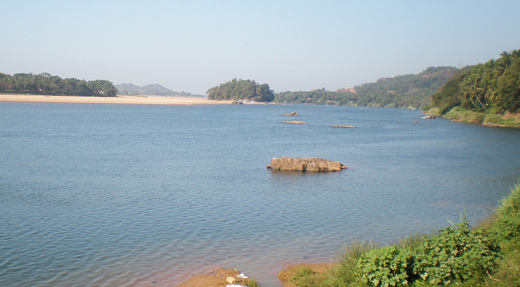
As Dakshina Kannadigas are gearing up to fight the project with distrastrous consequences, they are shell shocked at the lackadaisical approach of their newly elected representatives including the ministers from undivided DK district. Almost each one of them have expressed their ‘helplessness’ to drop the project, while pointing out that there was nothing they can do to stop the project which was given a go ahead by the erstwhile BJP Government.
It is nothing short of a stab in the back by these leaders. The Yettinahole project, nothing but a la- Netravathi diversion project, the name changed in all probability to hoodwink people, was given clearance in July 2012 when a man from the district, DV Sadananda Gowda was the chief minister Later, in February 2013, the Union Government as well as the Central Water commission cleared the project. In this case too, Karkala man M Veerappa Moily who holds the vital petroleum ministry, made no effort to stall the project but in fact supported it for the sole reason that it benefits his home constituency of Chikkaballapur, at the cost of his home district.
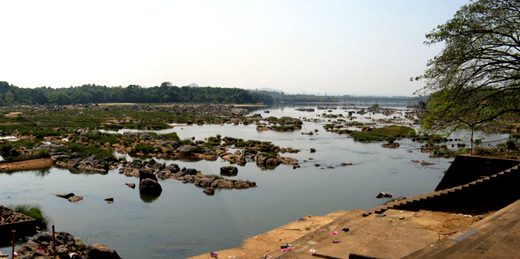
Now, the Congress government in the state is going ahead with this distastrous project and the elected representatives are mum on the issue, and whenever forced to speak up say there is nothing they can do.
““I am a Cabinet Minister and I cannot say anything on the Cabinet decision I cannot do anything. The previous government took a decision to go ahead with project,” says B Ramanatha Rai, DK District in-charge Minister who also holds the Forest and Ecology Portfolio. At the same time, Rai also favours a scientific study to prove the fact that the Yettinahole project does no harm.
Talk to UT Khader, State Health and Family Welfare Minister representing Mangalore (Ullal) Constituency and he too will voice the same sentiment.”The Project canot be stopped. There is nothing we can do now.Allocation for detailed project report was made in the budget and approved in the Assembly. We have only gone ahead by allocating funds for the project,” says Khader. “Nothing can be achieved if only 13 MLAs from the district oppose. The train has already left the station, We cannot stop it,” Khader too seems helpless when he says so.
Incidentally, the Health Minister is in-charge Minister of Kolar district, one of the beneficiaries of the proposed project and he is doing nothing but staking the interests of his home district to promote the interests of the district where he is in-charge, feel political observers.
Khader’s appointment as in-charge of Kolar district is also seen as a clever maneuver of the Congress leadership. It is believed even Rai’s appointment as Minister for Forest and Ecology was another way to gag the minister from saying or doing much regarding the project.
Khader on the other hand points fingers towards DV Sadananda Gowda, former CM, when he says “The project should have been stopped by our man when he had all the powers. But he allocated funds for the project, succumbing to pressure from MLAs from beneficiary districts,” Khader points out.
But, DVS justifies his decision when he says “ Yettinahole project and Netravathi River Diversion Projects are totally different projects. The ambitious Yettinahole project which aims at supplying water for parched regions of Kolar, Chikkaballapura and Tumkur, will not have any impact on Dakshina Kannada and Western Ghats." He further says he was strongly against Netravathi River diversion project which has negative effects on DK dstrict.” Gowda also allays fears and says the Yettinahole project will not affect lifeline of the coastal district and would leave Western ghats unharmed. There may not be many takers for his argument, as he is only justifying a decision taken by his government.
But experts contradict his views. “Yettinahole and Kumaradhara are Netravati’s major tributaries. Diverting Yettinahole is as good as diverting Netravati,”says Prof. SG Mayya, Chairman, Civil Engineering Department, NITK Suratkal.” The State government instead of diverting water should focus on providing water to the downstream, he observes.
Vanya Charana Balaga, a Forum of Forest Trekkers too feels the same. It argues that it is the Netravathi diversion project which is being implemented under the name of Yettinahole Project just to throw dust at public eyes. The Balaga has now chalked out an awareness drive in schools, colleges and organizations to sensitize public on the consequences of the proposed project.
Here’s a peek into the case history of this contentious project proposal. It was the then Yeddyurappa Government in the State which initially revived interest in this Netravathi River Diversion Project that had remained in cold storage for a few years. Initially, the project aimed at supplying the much needed water to 12 districts of the state including Bangalore. The draft of the project envisages that only the ‘excess’ of water from Netravathi that joins the sea every year, would be tapped for the purpose.
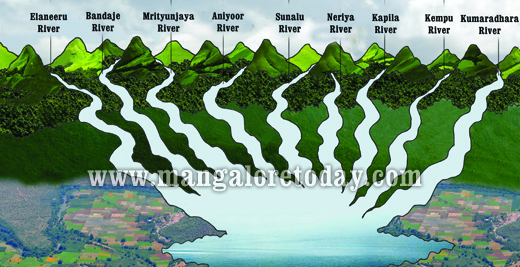
It was in the year 2003 that the then SM Krishna government, dusted out of the closet a thirty year old plan prepared by GS Paramashivaiah, then an irrigation department chief engineer, to redress the severe water shortage experienced by some districts of the state. When summoned, the official, long since retired, was more than willing to make a fresh study and present a draft proposal, no doubt spurred by the thought that his own hometown of Tumkur would be a prime beneficiary. As a result, a high power committee was formed under G. S. Paramashivaiah’s chairmanship. The report that he presented however instantly turned out to be a political bombshell, pitting environmentalists and NGOs in a headlong confrontation with the government establishment.
Though it was not much in the news later on, it stirred the hornet’s nest after the K C Reddy Committee submitted a second report. During the Kumaraswamy regime too passing remarks were made on this project with nothing concrete however emerging. But, it was Yeddyurappa who showed keenness in implement the project. In the year 2003, the State Government decided to pay Rs. 15.6 crore to the NRSA, an ISRO subsidiary, for the satellite survey. But the report was withheld when the government failed to pay the dues and finally though the report was out after all arrears cleared, it came to light that an aerial survey could not be done due to heavy rains. The then water resources minister Basavaraj Bommai had even charged the past governments of shelving the diversion project and had argued that water could be lifted to the districts at elevated level using latest technology.
Part of the reason for the paranoid frenzy about the project is the obvious scare caused by the title itself: ‘Netravathi River Diversion Project’ (short for ‘A Scheme for Gravity Diversion of Netravathi River to Drought affected villages of Karnataka’). The Dakshina Kannadigas, touchy as they are of their local heritage and identity, ought to be forgiven for their rage, considering that the scheme does not, as the name might suggest, mean to physically lift and divert their lifeline river.
What the project aims to do however something is far more discreet than this. The diversion of the river, in effect, means to trap nearly one third of the monsoon water (termed ‘excess’ water) washed off the peaks of the western ghats and transport the same to drought affected regions on the eastern side of the ghats. The river Netravathi does not in fact exist by that name in the ghats; its flow is actually fed by ten smaller tributaries which converge at various places to gradually emerge as the mighty Netravathi - the very lifeline of Dakshina Kannada. The water thus trapped and diverted by the project would hence reduce the water flow into the ten tributaries of the Netravathi. The project in short intends to divert the ‘excess monsoon water’ from west flowing Netravathi River towards east.
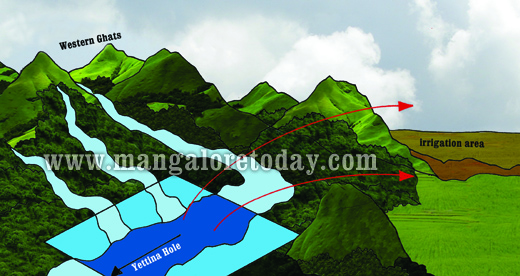
For Paramashivaiah “water is a national wealth and it should be shared among all people. What, according to him, is going to be done is tapping a very small area when compared to the extent of Western Ghats. The damage to environment, though not avoidable, will be almost negligible, says he.
The main allegation of the environmentalists against the report is that it never mentioned a single word about the negative effects of the project; rather it appears to be a one-sided argument. According to environmental activists, the river diversion project is going to be a great threat to the bio-diversity in the entire Western Ghats, which is considered to be one among the 25 rare biological hotspots on the globe. Says Sripadre, well-known water conservationist and an expert in rain water harvesting “The Netravathi river diversion project is a ‘colourful dream’ which is dangerous. Meddling with the nature in one of the hotspots of bio-diversity is wrong.”
The previous government itself had admitted that a total of 7,716 hectare ghats area will be submerged under water if the project is implemented. Kadamane, Ettinahalli, Edakumeri, the catchment areas of Kerihole, Hongada hole, Erutti hole, Lingada hole and Kumaradhara will also be submerged taking a large area of shola forests, flora and fauna under water.The 230 kms canal to be dug on the Western Ghats will disturb Subrahmanya reserve forest, Kadamakallu, Bisale rain forests, Pushpagiri reserve forest, Moojoor, Kombaru, Konaje reserve forest, Kangeri rain forest, Shiradi, Shishila, Miyaru reserve forest, Kudremukh National Park and so on. Perhaps, one need not explain the variety of living organisms in these regions.
The Paramashivaiah report contends that “the west flowing Netravathi river waters have been draining into the sea as a waste” and this water should be diverted to the dry districts of eastern Karnataka. By doing so there will be no shortage of food and water for the populations in these districts “for generations to come”. The scheme was claimed a novel one and the concept of garland canal a new thought”. The name is so chosen because the alignment of the proposed canal is below the peak line or ridge of the Western Ghats “which is meant to collect rain waters that precipitates on the western slopes of the Western Ghats”. The water so collected, is proposed to be diverted to fill all the existing tanks in the command area and also many proposed new tanks so that water is present even in summer. By doing this, the ground water will be recharged claim the reports.
According to the National policy, India is supposed to have 33% of its total landmass under forest cover: 60% for hilly tracts. But the actual figure is only 22% at present. In Karnataka the picture is even gloomier, with just 17% of the total area under forest cover. Even this forest cover is decreasing at an alarming rate particularly in the very region that has the highest forest cover i.e. the Western Ghats. According to official figures, more than 3.15 lakh hectares of prime forests have been lost in Karnataka from 1956 most of them in Western Ghats for various projects.
Presently, anti-river diversion movements are picking up as many NGOs and other pressure groups are bracing for a showdown with the government on the issue.
The state government has already issued a number of licenses to build hydro electric plants all along the 90 kilometer course of Netravathi river right from Gundya onwards. It has been learnt that 25 plants have placed demand for water in the river course. “There is a dire need for a movement to save the Netravathi not just by the people of Dakshina Kannada but also by the State,” say opponents of Yettinahole project.
Ananth Hegde Ashisara, Chairman of Western Ghat Workforce, had long back asserted that the diversion of Netravathi River is impracticable, as the plan has the potential to wreak havoc with the water sources of the Western Ghats, rich varieties of fish thriving in the river water and the lives of the people living in coastal Karnataka.
In the past, the proposal to connect River Bedti with Varada River had been dropped after it faced stiff resistance.Though advocators of such projects may argue that channeling the surplus water to underfed areas will solve the perennial problem of floods and droughts, there’s another side to the coin which spoils the rosy picture. A number of leading environmentalists are of the opinion that the project could be an ecological disaster.
According to Dr Vandana Shiva, one of India’s well-known environmentalist, such projects are based on the false assumptions that water from surplus rivers can be diverted to deficit rivers. “The truth is there are no surplus or deficit rivers. Rivers live where river basins have been ecologically managed, “observes Vandana.
Experts are of the strong view that the scheme has the potential to cause large and irreparable damage on a scale that is unimaginable. There would be loss of biodiversity, reduction in downstream flows, damage to fisheries and wild life and pressure created on land that might cause seismic tremors.
“The government should emphasise on promoting the traditional water harvesting and conservation methods instead of wasting money and time over such projects which is not result oriented, Sri Padre, eminent water conservationist had suggested long ago. Netravathi River had and has an important role to play in Tulu culture and its diversion could not be taken lightly. It is a perennial source of water for Dakshina Kannada. Any project that would disturb the ecological balance of the sensitive Western Ghats and is also likely to pose grave problems to life in the region, is unacceptable to the people. The project may be a technological marvel, but it will be an ecological disaster. Let Dakshina Kannada raise one voice against this project.
The ECOLOGICAL FACTOR
The Yettinahole Project has come in for very strong opposition from environmental groups, who argue that the diversion of river basins from their natural course of opposite direction is fundamentally unscientific and would greatly disturb the very pattern of landscape ecology. This, they point out, will result in problems like uneven percolation pattern, seepage problems, opening up of ground water sources in higher altitudes etc. It is clearly proven through many hydro-biological and geological studies that west and east flowing rivers from Western Ghat region have entirely different flow pattern.
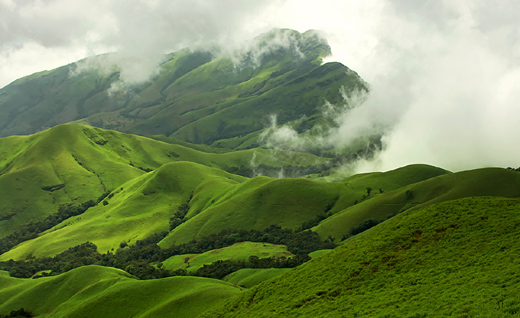
Also, the very notion that excess water or monsoon water flood lead to waste of water by draining into ocean is a wrong perception, they point out. All the rivers originating in higher altitudes of Western Ghats carry a huge volume of organic and inorganic nutrients along with water to down stream area. The coastal agriculture and aquatic organisms like fish will not survive without these nutrient sources. Any imbalance in this nutrient flow cycle may severely harm the coastal agri productivity and fish yield. As evidence they point to the severe fish drought already being seen in coastal Karnataka due to damage in their upstream Ghat regions.
The higher rainfall of Western Ghat region is attributed to its evergreen forests, high hilly terrain and unique valley pattern. The destruction of this sensitive ecosystem by this kind of projects may only lead to the rapid decrease in rainfall and also result in water scarcity. Besides these, other specific objections cited are - Western Ghat region, being one of the last remaining parts of rainforest heritage of the world is considered as one of the 25 biodiversity spots. It is already destroyed to a greater extent by many mega projects and this project would further damage the distinct ecological and social fabric.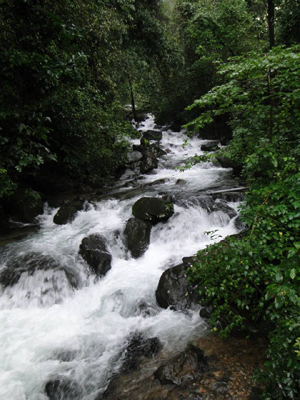 The precious flora, fauna and habitats will be in danger and there will be severe destruction of tiger and elephant corridors in Bedthi and Nethravathi river valley.
The precious flora, fauna and habitats will be in danger and there will be severe destruction of tiger and elephant corridors in Bedthi and Nethravathi river valley.
The likely damage to landscape pattern due to digging and construction activity could lead to depletion of surface water bodies and ground water sources due to seepage and indiscriminate percolation in unwanted area. This could lead to drought both in west and east downstream. Once the perennial water sources like springs, rivers, streams, ponds and wells are destroyed through this process - the damage could well be irreversible.
The project undermines the importance of monsoon flood as river rejuvenator, silt remover and unchoking agents. Hence reduction in water flow in downstream of the rivers in their natural course may lead to choking and silting in downstream river and its tributaries.
Excess water logged condition and soil salinity is expected in the immediate upstream in and around the reservoirs. It will harm the thousands of farmers around these areas. Saline seawater may enter coastal inland through river mouths because of low water level in downstream due to this diversion. This will make the fresh water bodies saline and destroy the water security of the people.
Digging canals and tunnels across the different river basins from west to east is of great threat to Western Ghats, which is ecologically sensitive and siesmographically fragile and prone to earthquakes.
Kudremukh National Park, which falls in the proposed Nethravathi project area, would be severely disturbed.
- Need For ‘Students, Alcohol and Drugs’ survey
- New Synthetic Drugs Trapping Youth
- Mood Modifying Chips - Future of Drug Use
- Ramping up Indo-Bangla border security
- IITM- A premier educational Institution in a forest. What can we learn?
- Former PM, Manmohan Singh: Notable laws passed under his tenure
- Hashish on Ratnagiri Seashore
- The Poor cry out to Us: Do we respond?
- Clandestine Meth Labs Sprouting Across India
- Hydro ganja from Bangkok latest craze among youth in India
- "Memories to Treasure" Dr.Michael Lobo’s new book
- Dominance of Private Universities: Will it make education inaccessible to underprivileged students?
- Monti Phest: A rich heritage of South Canara
- Kashmir Bhavan in Bengaluru: A must visit place
- "MAI and I" Book of Angelic Emotions
- Draupadi Murmu - The New ’President of India’
- Anthony Ashram in the city grows a classic museum
- First College of Fisheries in India - A Golden Jubilarian
- Flushing Meadows - A Vintage Mansion
- The Colonel�s Bequest
- A Mangalorean PM and his RBI Governor Brother: The Extraordinary story of the Benegal Brothers
- There is no higher religion than Truth: Theosophical Society
- L�affaire - Ashu & Yiju of Mangalore
- Mangalore in Kowloon
- 1568 to 2018 AD: 450 years of Christianity in Mangaluru
- Vice President elect Naidu moves on from nadir to zenith, the phenomenal journey
- Embracing the Outdoors: How Heated Jackets Are Revolutionizing Cold Weather Activities
- Efficient and Sustainable Packaging Solutions with FIBCs
- The Hybrid Kilt Revolution | Where Tradition Gets Trendy
- Affordable Elegance | Embrace Style on a Budget with Cheap Kilts
- Unleashing Style and Functionality | Exploring Tactical Kilts
- Mangalore’s Heroic Lady marks 105th Birthday
- Santa the Christmas spirit
- Geriatric care: Mangalore strikes a fine balance
- The Don Who Made Two Empires to Clash
- CHITRAPUR SARASWATS - A Great Kanara Community
- Our new President Ram Nath Kovind’s significant journey to Rashtrapathi Bhavan
- Marriages made in heaven, big fat weddings made in India
- Eid insight - The giver of glad tidings
| Comments on this Article | |
| Mountainview, belthangady | Mon, October-26-2015, 4:23 |
| Time for Coastal districts of S.K, Udupi, Kasaragod, Uttar Kannada and Rathnagiri to create Tulu-Konkana Nadu Is it not time to stop being a part of the most corrupt (mamool) Karinataka? | |
| girish shetty, Mangaluru | Mon, September-14-2015, 10:45 |
| Its one side dirty politics...there is any guts in our coastal side mp,mla’s they have to be resign their post against this....And now also they have time to show unity....And i strongly oppose this type of total lose... bcz its not worth.... | |
| appan varma, thrissur | Sat, September-12-2015, 1:26 |
| S.K has 8 continous non raiy months with its rivers becoming filthy pools as seen at Kollur , Subramoniam and Dharmasthala. Sea water intrusion into the rivers stretch up.Demand for water for personal use has increased and wells in many pts even dry up due to pumped use.SK wants storage of the water going waste to sea.Plan the projects so that the future demands of Mangaluru , Udipi etc are saved.The galata must be for this .Revival of Kudrmukku forest ( mines closed ) will enhance flows too | |
- CITY INFORMATION
- TRAVEL
- TOURIST INFORMATION
- HEALTH CARE
- MISCELLANEOUS




 Write Comment
Write Comment E-Mail To a Friend
E-Mail To a Friend Facebook
Facebook Twitter
Twitter  Print
Print 


